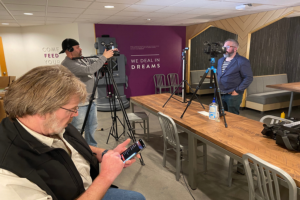When people ask me what NEXT Lab™ is, despite its inherent complexity, it’s usually a pretty short answer — we have a “cool job” — upon elaborating I usually wind up down a rabbit hole involving virtual reality, holograms, robots and flashing lights and then it seems to click — “you do have a cool job”. That’s the beauty of working with technology, the experience of it can be wildly simple (cool) and incredible complex (also cool) — we get to make the impossible.
During a recent brainstorming session, we were throwing out ideas for a virtual engagement and a client asked if we had done what we were describing for another project, it seemed complex and in their words “impossible” to build what we all had in mind. I confidently said “no” — there was a pause — and then I explained that for over 40 years Exhibit Concepts has crafted our reputation on designing, building and implementing custom solutions for clients around the globe. We don’t shy away from difficult or new or never seen before – that’s what makes it “custom”. Anyone can build the impossible with the right approach.
So how do you possibly start creating something your client thinks is “impossible”? Here are some steps you can take when assessing solutions and how you can vet the wildest ideas to bring them to life.
#1 START WITH THE END
“Wow factor” can mask goals so easily — if you start with the tech or the creative without knowing what you’re trying to accomplish you’re going to have a very tough go actually getting to a successful finished product. In EVERY project NEXT Lab™ tackles we always start with the goal — knowing full well there are lots of paths to get there — but alignment on that goal gives you an anchor for your project. Keep your eyes on the goal, question your solution against the goal and remind your team and client of the goal if either stray from the course.
#2 RESEARCH – LET ME GOOGLE THAT FOR YOU
Once you have your goal in mind and you’re working on how to get there, you have a brainstorm or a discovery meeting to start to feel out how to accomplish said goal in the coolest but most effective way possible. You craft a creative direction, one you’ve never done before and then — you sit and probably try and think of an easier approach. I always encourage our team to research, research, research. Google stuff, YouTube stuff, TikTok stuff? Regardless of your channel, see how others have solved similar goals — survey the scene and compile some ideas. You’ll be incredibly surprised how far 30 minutes of research can get you these days. Even if you can’t find a perfect match to your problem, you’re definitely closer than you were prior to researching.
#3 MVP – MINIMAL VIABLE PRODUCT
This is my favorite part of the process! An MVP is the “duct tape and cardboard” version of getting to your goal. No need for any polish — MAKE SOMETHING. If you have an idea, try it — build a mock-up out of paper for a digital engagement, make a cardboard kiosk, test scale in virtual reality all while grabbing feedback from anyone and everyone. Make sure your MVP is still resulting in the goal — that’s the only way you know it’s working.
#4 KNOW YOUR LIMITS – FIND THE EXPERTS AND DON’T BE AFRAID TO LEAVE YOUR FOUR WALLS
I’m a big fan of phoning a friend. If we research and MVP and can’t quite get our idea to that polished end state — find an expert who can. Never be afraid to outsource bits and pieces of your solution if it helps you and your clients achieve your goals. Work hand-in-hand with the right vendors to get to a finished product and use your research and MVP to guide you. It’s very ok to not have every skill set in house. When the speed and technology behind the impossible evolves, you should actively have a Rolodex of experts who can help.
#5 BE AGILE AND EVOLVE
Not every impossible idea is a home-run and not every step of creation will be perfect. When dealing with wild and complex ideas, it’s important to fail fast, shift gears quickly and evolve your solution with every speed bump you may encounter. I recommend breaking your development and creation into smaller accessible pieces that can be checked off or completed to keep you inching towards something that’s complete, done and goal achieving! Also — talk about your solution once you’re done — talk through what worked, what didn’t and how you can improve. Now that you’ve done the impossible once, you have a ‘lesson to learn from’.
Creating custom is no easy task but in the interest of saying ‘yes’ to the cool, wild and wonderful — plotting a process will bring you success in the creation of “impossible” projects.









